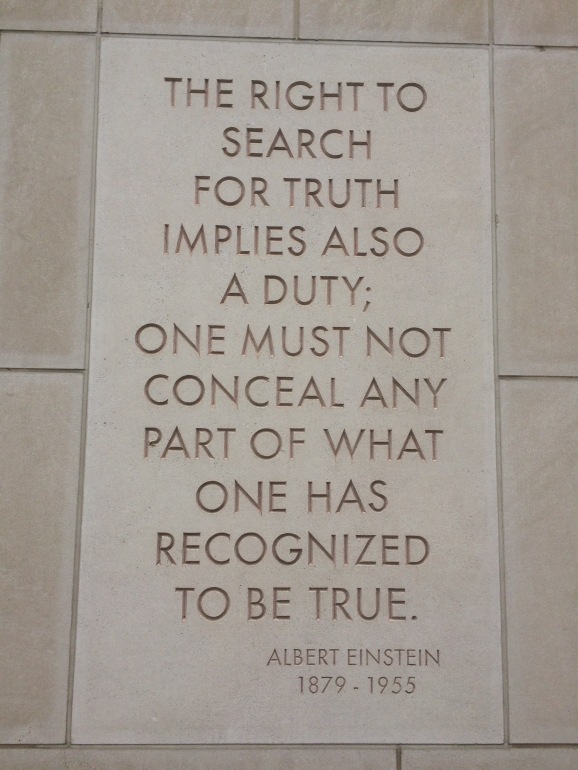Returning to Practice
I’ve been interviewing Millennials for work.
In one sense, that is no surprise at all. Many of the students applying for graduate programs stay in the same age range. I have, by contrast, gotten older. Incoming students who were approximately my age (or older) are now the age of my children (or younger). This is the nature of the cycle of life (cue the music from “The Lion King,” which is now considered “Classic Disney”). So, why was this experience different?
First, and most important, was that I was not interviewing people for work in the Lab. These were postdoctoral fellows applicants for Department of State positions. The vast majority of them are still just a few years from their PhD dissertation, experiencing a very different world and context than I did when I was interviewing for my first faculty position. Well, that suggests another difference: I interviewed for a faculty position, and never seriously considered a postdoc. I have spent months engaged with discussions of the role of scientists and engineers engaged in Science Diplomacy, and the interplay of innovation and policy—quite frankly, the education I had come to Washington to have in this very interesting and challenging period. These folks aren’t being recruited to work on my favorite projects, or to have exactly the sort of background I would like a GROUPER to have… but there was still a request from my unit chief for what sorts of people to identify in the stack of resumes and personal statements.
Signs of life.
I was starting to wonder about what that would look like in this context, and in fact, I was starting to question if my time away from the university had left me cynical or unable to see beyond my own narrow daily priorities. Maybe it was a broader sense of unease with the sudden transition from a snowstorm in late March to 90 degree days in late April. Where and how and when was I operating? (I had come to feel a certain sense of stress and negative anticipation regarding my transition back to Purdue, starting in late March when I was requested to provide new course syllabi for my Fall classes. There are new opportunities for next academic year, but after eight months here in Washington, I am neither ready to start right back in on the academic world, nor think in terms of another full annual cycle of activity here.)
And yet, my unit chief wanted me to not only be involved in the interviews, but to craft a few questions for them. It was, as I have said before, a bit different to operate in support of others, instead of being my own “Principal,” but that is part of my learning these days. I’ve also been learning a lot about the differences in cultures of science, and hearing about the distinct experiences of what I have come to call, “Millennial Scholars” (those who may be part of the generation born in 1985 or later, but also have completed their advanced STEM degree programs since 2010). I’ve even produced a few of those people myself, but I already knew enough not to look for people just like Ashley or Karim or Marissa or Jeff (or those who are in the lab now). The discussions in the AAAS meetings in Boston and Washington still had an immediacy and curiosity to me: I was meeting so many people interested in a concept, science policy, that I had long thought was an oxymoron. Why were they interested in this? What new was going on?
What are the challenges and opportunities, strengths and weaknesses, of these Millennial Scholars?
This is, in my experience with the lab, a “signs of life” question. Signs of life it had become a part of my thinking at a time where spring is definitely upon us in Washington. I’m walking much more around the city again, and over the past few weeks, I have been able to enjoy the cherry blossoms and new plants and warm weather. In other words, “signs of life returning” was part of my daily experience.

Figure 1. Signs of life: Tulips at the bus stop
The answers were also informative, as well as reminders of an earlier age. There were those who seemed to have trouble thinking about themselves, and their colleagues, in such a comparative context. However, this compared to several who actually commented about the relative lack of a sense of historical comparison as a weakness of Millennials. What was another weakness? There were several comments about the ease with which new information and new activities and experiences were available, leading to a sense of being dabblers in a variety of skills (“jacks / jills of all trades, masters of none”). In fact, that ease of collecting and novelty even extended to the strengths and weaknesses of networking. Although the world of embassies and interagency discussions and think tank receptions clearly indicates a value to the work of engaging with others… there is a difference between engaging in an effective, distributed knowledge network, and collecting friends and likes as a way of keeping score.
I found myself curiously replaying one conversation in my mind, about the concept that Millennials were more interested in finding ways to align their actions and employment with their passions. Now remember, I lived in Cambridge, MA and California during the 1980s startup crazes, where people were all about passion. I heard the Flower Children talking about living a life of meaning and service. And, most importantly, I have learned how much my career as a professor is actually well aligned with my passion for exploration and sharing what I found.

Figure 2. Albert sharing a sense of passion. Maybe science diplomacy was never so far from my thinking after all. (At the National Academies Keck Center, 500 E St NW)
Was this really different? And then I heard an interesting alternative take on this thought. “Well, if I can’t rely on a pension or Social Security to be around, there is no reason for me to trade boredom for security.” From that discussion, I was transported back to the first few times I taught the course Sociotechnical Systems at Wisconsin. I had known about two different models of work and income as “covenants”: income and status as a way of demonstrating success and favor, or work as a demonstration of one’s passion and artisan’s skills. It took discussion and debate in class for me to learn that there was a large population with a third approach: work was something one does to get enough income to spend the rest of one’s time doing what one really preferred to do. Apparently, lots of people live that way, whether they’re working second shift at the auto parts store, or vice president of global distribution for the auto parts company. I have not chosen to live that way, and I can’t really imagine doing something I hate just to have the income to do what I love, later. Is that what others were assuming we were all doing? Or were others doing this a lot more than I was ever aware?
I felt like I had come full circle in the discussion, and my awareness of my own experience as a young scholar. I am convinced that there are confusions in each generation, not sensing the range or intensity of experience from when prior generations were young and emerging, like new plants bursting into the sunlight and struggling against snow and wind and dangerous frost. I can appreciate it much more now, because I have been in both places, and I have come to feel them both. I am not yet done with the intensity of feeling and learning. And yes, I am still pleased to take a moment on a Spring day and feel the sensual joy of lamb’s ear as I walk from meeting to office or home. Because, even after a great enlightenment, a return to practice and repeat of small things still has value.

Figure 3. Lamb’s ear on 19th St NW. A good reminder of small lessons.



July 30, 2017
The Last Weekend, Part 1: Talking in Jazz
“It’s a beautiful day outside. I wish they could all be like today.”
“It is wonderful. I’m glad we have any day like today.”
The past two weeks have included some of the most beautiful weather one could hope for in Washington. Of course, we’ve also had the thunderstorms, and flood warnings, and 95F weather, but today was wonderful. As a result, it was easy to take a few extra minutes to walk around the various neighborhoods and take in moments of beauty and peace on what is, amazingly, my last full weekend of The Adventure here in DC. (Next weekend, I will be on campus for Commencement and Liang’s PhD hooding; after that, it will be moves with Amber and myself, taking up much of my attention.) A sunny day, with a bit of breeze and clear blue skies to allow my mind to explore and expand across my internal and external landscape. Walking around down on the National Mall can even have those moments of peace among all of the people, if one listens. Hear that? A musician busking across from the Museum of Natural History, or in front of the Museum of American History. What’s that singer singing, at Lafayette Square next to the White House?
One thing that has helped me gain a sense of balance while I have been here has been the effort to take the time to notice and appreciate elements of nature and ephemeral beauty when they occur. I noticed this earlier this month, when (on an early Monday morning return from Indiana) I was listening to a delightfully resonant piece of music while walking among one of our busy commuting streets. Taking pleasure in the music (perhaps I was dancing just a little bit?) was something that could emanate easily in that sense of pleasure and enjoyment; people I passed brightened up a bit and smiled. Why was the music so important? Recently, I have come to the realization that I don’t just want to hear the music, I want to allow and enable others to hear that resonant tune that brings joy to the face or even a tear to the eye. So, it’s been on my mind a lot recently.
Imagine, then, a cool and sunny day earlier this week (yes, in July, in Washington); I crossed the street and, just as I walked past an old streetlight on my way into the office, a breeze caught and rustled my clothes and touched my face. This was truly a gift of sensory awareness. I looked up, and there between the old streetlight and a new tree, silhouetted by the sun, was a delightful dragonfly moving between branch and blossom.
“Dragonfly out in the sun, you know what I mean, don’t you know…
“And this old world is a new world and a bold world for me… And I’m feelin’ good.”
An actual dragonfly gave me the reminder of the shared experience of the classic Nina Simone tune, Feelin’ Good. How can I be upset about that? That was the start of a very productive day.
Hearing the jazz in a moment’s pause on the way into work… and wanting to share that with others. Recently, I was told by one or two GROUPERs, and my best friend, that I “talk in jazz”. How can that be? What can that mean? Well, imagine that people studying a discipline are learning to recognize notes and specific tunes. Well, one can play a melody using nothing but tuning forks, and someone could recognize a snippet of a Brandenburg Concerto, or a rock anthem, or a jazz standard. But most of us would not go to a concert to hear that. We want to hear the instrumentation, and the virtuosic performance, and maybe a unique interpretation. Especially in jazz, that unique interpretation does not just stay on the melody, but is a combination of skill with the basic melody and rhythm, and the ability to experiment with it within boundaries, while remaining honest to the structure and returning to the theme in time. (Perhaps my upbringing has something to do with this. I remember, as a young kid, reading the liner notes to a jazz album; I think it was Miles Davis’ “’Round About Midnight”. One of the solo riffs during the title song has a distinctive reference to “Take Me Out to the Ballgame” as a type of musical joke—a baseball game at midnight? It’s where the musician went, and took us with him. I learned to hear the song differently because of those liner notes.)
Scan and connect; read widely and question deeply. Those are mottos of the lab, and critical elements of my personal philosophy. Don’t just hear the melody… listen for the nuggets in between. (Fortunately, as my son has gotten more accomplished in music, he has forgiven me for my strange form of dancing. Maybe Dad isn’t completely lacking in rhythm. Maybe he’s trying to dance to all of the notes.) Megan and I were sitting in a restaurant while she told me about this idea of talking in jazz, or in other words, talking around the answer. No, I am not meaning to tease my students, or in a more predatory sense, “play with my food”. I can hear much more, and want to share it, in the complexity and richness that some of the world appears. “Experience is a convolution function that elicits latent segments of the matrix of personality set” was something else I said to Megan. That’s not play. That might be an alternative time signature, or some unique syncopation… it’s also a reference to one of the pieces of the Cassandra’s Postcards entry.
Maybe I need to be reminded to play the melody a bit more often. W. Ross Ashby wrote a cybernetics text on “requisite variety,” which suggests the complexity of genetic variability is what gives us adaptive range in a variety of environmental conditions. That adaptive range is not always tested, if the environment doesn’t change. The genetic variability doesn’t go away, though. It is only when tested with changing environmental conditions that the relative value of variability is highlighted… in individuals or in populations. But just getting people to read and recite Ashby’s Law of Cybernetics is like playing the melody of Feelin’ Good on a set of tuning forks. We don’t learn important questions there: How is it used? What does it evoke? What do we learn by that experience?
I have already started to recognize elements of my experience here that I will miss once I return to Indiana. But there is a richness of available experience everywhere, and it is wonderful whenever I can experience it in beauty and pleasure. A summer day with bright sun and blue skies is a great opportunity. And guess what? I even got a moment to replay a bit of the melody: another dragonfly.
Figure 1. Dragonfly: You know what I mean.
Share this: